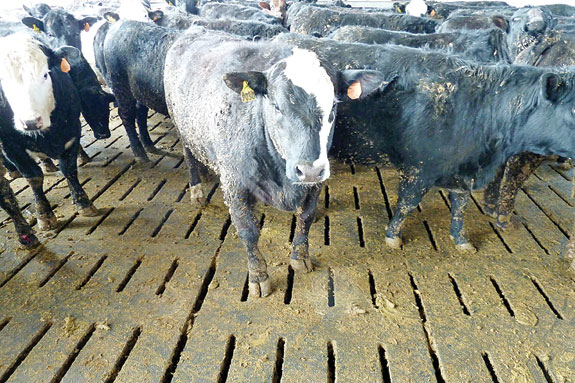These occurrences, coupled with the large investment involved with a new feedlot facility, make cattle feeding margins very tight and force feedlot managers to be as efficient as possible when managing their feedlots.
Due to the harsh climate in the Upper Midwest, we are often at the forefront of feedlot design to minimize the effects of climate on cattle performance. This has certainly been evident over the last 10 years with the increased presence of bedpack facilities and, in particular, monoslope facilities.
Facilities like these have been extremely valuable in the past year providing protection from a harsh winter as well as from the extreme heat and humidity experienced this summer.
More recently, there has been renewed interest in slatted-floor facilities. These feedlot facilities offer advantages in that they retain most of the nutrient value of excreted manure, have a smaller footprint than other facility types and require little if any bedding.
The smaller acreage required, as well as the improved manure quality, are important aspects for the diversified feeder-farmers that make up most of the Upper Midwest feedlot industry.
When considering new construction, the decision needs to be based on a number of factors. Among these are type of cattle to house, land available, value/topography of land and the local feedlot environment.
Monoslope facility
The basic dirt-surfaced, open-pen feedlot still has a place in the industry, and recent feedlot expansions of this type have been successful.
This type is the lowest cost for new construction or expansion, which is likely the greatest advantage, while disadvantages such as limited protection from the environment, need for occasional bedding and partial loss of manure nutrient value due to volatilization need to be considered as well.
This type of facility works well if adequate land is available and the land has some slope, preferably a south-facing slope.
These facilities typically allow approximately 250 square feet of pen space per head, so a large amount of land is needed to construct this type of facility.
Bedpack monoslope facilities provide advantages over open lots in that they provide more protection from the climate. Their cost is typically about twice per headspace of an open lot.
These facilities also require increased management in the form of increased bedding, scraping and manure hauling.
A general rule is to assume that each headspace will require approximately five pounds of bedding per day, which equates to nearly one ton of bedding per headspace annually. For a 1,000-head feedlot, this means that approximately 2,000 corn stalk bales (or other form of bedding) will be needed each year.
This is certainly an important consideration for this facility type. However, it is hard to argue with the predictability of performance that these facilities allow.
Cattle in monoslope facilities perform relatively consistently throughout the year regardless of climate, whereas cattle in open lots will vary in performance based on climatic conditions.
Cattle in these facilities are typically allotted approximately 40 to 45 square feet per head, or approximately one-sixth of what is allowed in an open lot.

Slatted-floor facilities
These facilities provide an advantage over monoslopes in that they require a smaller footprint and very little, if any, bedding.
Cattle in this facility type are generally allotted between 20 to 25 square feet per head, or approximately half of what is allowed in a monoslope.
Slatted-floor facilities also allow for retention of manure nutrient value in the form of liquid manure and, in most cases, these facilities are designed to allow for once-yearly manure hauling.
This type of facility requires much less management than a monoslope facility or even an open lot, but comes at a greater cost. Slatted floor facilities will typically cost approximately 50 percent more than a monoslope facility and three times as much as an open lot.
A second potential disadvantage of this type of facility is the greater prevalence of feet and leg problems due to concrete floors or slats.
In many cases, producers only place cattle on slats that are within 100 to 125 days of harvest, though successful longer-term feeding has been reported.
Some producers report that 2 to 5 percent of cattle will not finish on slats and will need to be moved to a dirt surface or bedpack facility. Rubber mats are available to place over slats to allow for improved cattle comfort, although the cost of the pads ranges from $75 to $175 per headspace.
Performance and pounds
Performance comparisons are difficult to make because they are highly dependent on climate. Data from South Dakota State’s Opportunities Farm show an advantage in a monoslope and a partially covered lot compared with an open lot in the fall and winter, but the advantage was not present in the spring or summer.
In general, cattle will perform similarly in dry, warm weather and the confinement facilities will provide advantages in poorer conditions.
Feed intake will generally be reduced by approximately 5 to 10 percent in the slatted floor facilities due to less bunk space, limited water space or other factors.
However, the reduction in gain is generally not as great, resulting in comparatively greater feed efficiency in slatted-floor facilities.
The bottom line is that management can be the difference between profits and losses in any facility. Though some facilities may provide advantages over others, these advantages can quickly be negated by poor management.
The decision in building or expanding will depend on a number of the factors mentioned above, and there is no ideal facility type to fit the goals of every producer. ![]()
—Excerpts originally from the Minnesota Farm Guide.
PHOTOS
TOP: Slatted floor facilities allow for more retention of manure nutrient value in the form of liquid manure.
BOTTOM: Rubber slatted mats help provide more cattle comfort and prevent feet and leg problems. Photos courtesy of Animat.
Grant Crawford
Beef Technical Services Director
University of Minnesota







